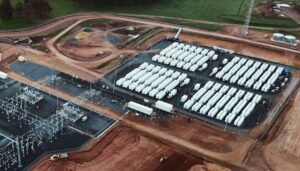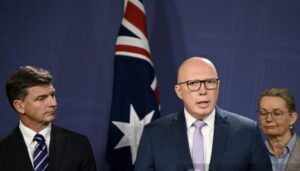So, this is the full renewable energy catastrophe for Australia.
After painting the worst possible scenario, and factoring in the most gloomy technology cost estimates, the most virulent anti-green business forces in Australia have come to the conclusion that the renewable energy target is having such a devastating impact that it is costing the average household …… wait for it …. drum roll …… less than $1 a week.
And that’s without counting its benefits.
For this, the Business Council of Australia, the Australian Chamber of Commerce and Industry, and the Minerals Council of Australia, would dearly love the Abbott government to risk its remaining political capital and scrap the RET completely, at the cost of thousands of jobs and billions of dollars of clean energy investment.
But they have actually stopped short of making such a strident and politically untenable call. Instead, the three lobby groups have suggested that the RET be adjusted to a “real 20 per cent” target – a change that would still scrap billions of dollars of green energy, and thousands of jobs, but would bolster the profits of existing coal and gas-fired generator. And it would save households the grand sum of ….. 50c a week.
The report from Deloitte Access Economics has been keenly awaited – ever since a snippet of its supposed “devastating” modeling was trumpeted with great fanfare by the Murdoch press in June. In many ways it was considered to be the final roll of the dice for the fossil fuel lobby against their green energy rivals.
Instead, it has produced a damp squib. It has simply reinforced what everyone already knew – that making changes to the renewable energy target delivers the greatest benefits to incumbent fossil fuel industry, and satisfaction to conservative ideologues. It is not about the cost of consumers at all, otherwise they would be applying their modelling and their economic gobbledygook to much greater threats to household bills, soaring gas prices and rising network costs.
But let’s put this in context.
It was expected that the Abbott government would drive its truck right through the RET, despite its stated bipartisan support before the election. In choosing to bypass the Climate Change Authority, which has the statutory requirement to conduct the current RET review, and appointing instead an “independent” panel comprising two people – Dick Warburton and Shirley In’t Veld – who do not accept the science of global warming, and another – Brian Fisher – with strong interests in lobbying for fossil fuel interests, the government made its intentions clear.
Two realities have thrown a spanner in the works.
The first is economic – they simply haven’t been able to produce economic modeling that justifies their position. Even ACIL Allen, sometimes described as the fossil fuel industry’s modellers of choice (it prepared the anti-RET submissions of EnergyAustralia) concluded in its report to the RET review panel that households and businesses get a long term benefit from keeping the renewable energy target as is. And it agreed, contrary to the protestations of the incumbent utilities, that the target could be met if the industry was given policy certainty.
Instead, it sought to base opposition to the RET – and the construction of wind and solar farms, and the installation of rooftop solar – as a “transfer of wealth” from fossil fuel generators to the consumer, as though that prospect would somehow cause outrage in middle Australia.
The second reality is political. Abbott does not have the numbers in the Senate to force through changes to the RET. The Palmer United Party and Ricky Muir stand in their way, and as the cheerleaders in the Murdoch media trumpeted today, may only be dissuaded with convincing economic arguments against their position.
Hence the need for the lobby groups to produce some killer modelling with the help of Deloitte. But to reach even its own modest impact, Deloitte had to imagine the impossible – that the capital costs of wind and solar in 2020 would be twice that modeled by ACIL Allen (itself based on a somewhat conservative forecast).
Then Deloitte had to imagine that the fall in wholesale prices caused by the influx of renewables would somehow be less than half of what every other independent analysis predicted. And finally it had to throw in some economic gobbledygook to justify its claims that the RET would cost the economy 5,000 jobs and $28 billion. There was no modeling on the jobs created and the economic benefits of actually building $20 billion of wind and solar energy.
Where ACIL Allen saw a transfer of wealth from fossil fuel to consumers, Deloitte saw a transfer of consumers to renewable generators.
Is that really the best that they can do? Perhaps it would be best to come clean with the real reasons why these three lobby groups decry the RET, while others such as the Australian Industry Group insist that the RET must continue as is.
The reasons are simple. BCA and MCA represent some the vested interests and extractive industries threatened by the transition to clean and renewable energy sources and the emergence of new, disruptive business models. Their opposition is designed to delay the inevitable, when science, long-term economic analysis and popular opinion calls for the transition to accelerate.
 Others, such as ACCI’s chief economist Burchell Wilson, just don’t like renewable energy. Last year he described the RET as “crazy” and “bad policy”. Renewable energy, he said, is “producing a product that no one wants to buy.”
Others, such as ACCI’s chief economist Burchell Wilson, just don’t like renewable energy. Last year he described the RET as “crazy” and “bad policy”. Renewable energy, he said, is “producing a product that no one wants to buy.”
That sort of thinking has a lot of sympathy within Cabinet. Joe Hockey thinks wind turbines are “utterly offensive”, Tony Abbott fears they are growing like mushrooms and renewables don’t work when the sun don’t shine and the wind don’t blow. Agriculture Minister Barnaby Joyce last year lamented the “insane lemming-like desire to go to renewables.”
But any plans to bring the RET to a sudden halt, or even diluting it to a “real 20 per cent” target look certain to by stymied by the Senate, where Palmer’s proxies have decided to defend the current 41,000GWh target – at least until 2016.
Given that opposition, it’s hard to imagine Abbott risking more political capital for the sake of 50c a week per household. It’s even harder particularly when renewables, and rooftop solar in particular, are so popular with the electorate.
Unfortunately, the position of Palmer et al amounts to little more than a stay of execution for the renewable industry. Deferring the debate until 2016 simply does not provide the long-term certainty for off-take agreements and financing to be signed and trigger the $15-$20 billion.
Abbott knows that he can effectively bring the industry to a halt simply by doing nothing and allowing the uncertainty to linger. It’s worked for the last 18 months – with investment in large-scale renewables at their lowest level since 2001. The entire clean energy transition has been funded from the wallets of individual households and businesses, who are investing several billion dollars a year installing rooftop solar.
As for the report commissioned by the lobbyists, perhaps the most damming assessment comes from Deloitte itself. At the conclusion it includes a small paragraph under the title of “Limitations of our work”
“This report is prepared solely for the use of the Australian Chamber of Commerce and Industry,” it says. “This report is not intended to and should not be used or relied upon by anyone else and we accept no duty of care to any other person or entity.”
Enough said.










